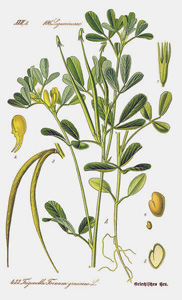Fenugreek:
The Literal Hayseed

Give the patient either pure milk to drink as a remedy or else fenugreek, which is grown for fodder and puts forth curving horns amid its windswept leaves. . .
Nicander of Colophon
Cattle and other livestock adore fenugreek, so much so that veterinarians used to add it to the food of sick animals, to convince them to eat. Similar in appearance to alfalfa, it is often mixed with moldy or inferior hay to convince livestock to consume that as well.
Fenugreek, in fact, derives its name from the Latin foenum graecum ("Greek hay"), and has also been called "hayseed" or "bird's foot." It grows to about two feet with yellow, pea-like flowers, and its official name trigonella ("three angled") describes the flowers' corollas.
Native to the Middle East and western Asia, fenugreek has a flavor that Michael Castleman's Healing Herbs calls "an odd combination of bitter celery and maple syrup." When roasted, the seeds take on a caramel-like taste. So they often flavor fake maple syrup as well as curries, pickles, chutneys, and other dishes. The somewhat bitter young shoots can also be used in salads.
Despite all the deceptions in which it has participated, fenugreek is genuinely good for you. It reduces both cholesterol and blood sugar and is also high in vitamins and minerals, especially choline which helps prevent memory loss and selenium which helps prevent cancer. Keep in mind, however, that women in some parts of the world eat the appetite-stimulating plant to gain weight--especially in their bust lines!
Fenugreek was one of the ingredients in Lydia Pinkham's Vegetable Compound for women, along with pleurisy root, ragwort root, unicorn root, and black cohosh. Although such patent medicines--marketed during the Victorian era--were often scorned, fenugreek does contain phytoestrogens which may ease menopausal symptoms and promote milk flow in nursing mothers. Pregnant women shouldn't consume it, however, since it may cause uterine contractions as well.
When soaked in water, fenugreek's seeds produce mucilage, which can soothe sore throats, boils, and etc. But Jews also poured the slimy stuff on the ladders used by invading Romans during the siege of Jerusalem.
Although fenugreek didn't help much that time, legumes are often considered lucky. Perhaps the fact that they add nitrogen to soil convinces the superstitious that they will add richness elsewhere as well!
Jews use fenugreek in early autumn during the celebration of their new year, Rosh Hashanah. According to The Encyclopedia of Jewish Food by Gil Marks, the plant's Aramaic name rubia sounds similar to a common greeting at that season, "Sheh-yirbu." It sounds like a good wish for the January New Year as well. "May our merits" (like those of fenugreek) "increase!"
Trigonella foenum-graecum image is from Dr. Otto Wilhelm Thomé's Flora von Deutschland, Österreich und der Schweiz, courtesy of Wikipedia.








